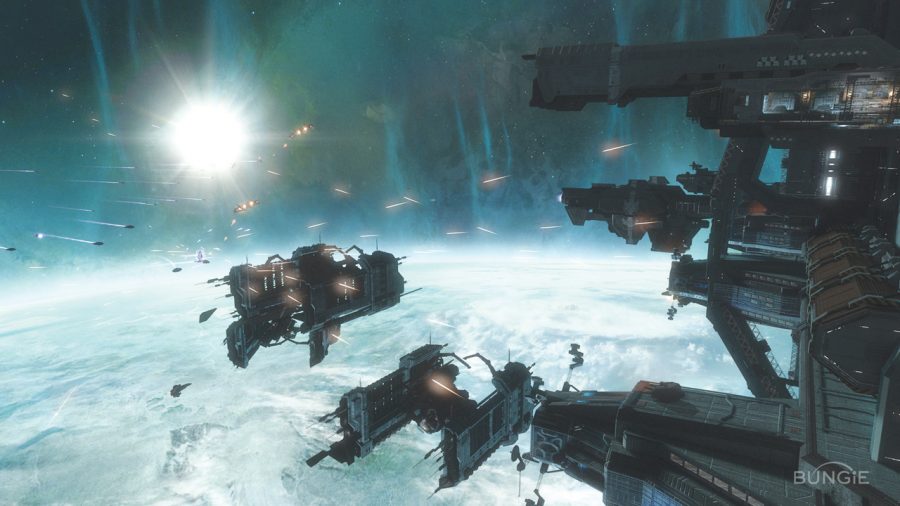Whether or not you believe Bungie’s statement, “There will be no more Halo after ‘Halo 3’ … we mean ‘Reach,’” or that Microsoft will be taking the franchise and running it into the ground (“Super Halo Kart,” anyone?), for all intents and purposes, we can consider “Halo: Reach” to be Bungie’s magnum opus of the series.
It’s a culmination of all the ideas, storytelling and technology they have fostered since “Halo: Combat Evolved” back in 2001.
“Halo: Reach” is the prequel to the original Halo trilogy, which followed Spartan soldier John-117, a.k.a. Master Chief, from the first Halo ring-world back to Earth and eventually to his supposed death (Spartans never die, they only go MIA).
In “Reach,” the player takes the form of a Spartan known simply as “Noble 6” who joins a squad of Spartans referred to as “Noble Team” as they investigate the newfound presence of the Covenant, an alien religious cult, on the planet Reach.
Those familiar with the story of “The Fall of Reach” already know what starts as a small insurgency of Covenant soldiers quickly escalates into all-out war as the alien cultists search for an artifact hidden on the planet. Reach eventually falls to the Covenant and their superior firepower and, as is known from “Halo: CE,” the only Spartan to survive is Master Chief.
Knowing the end beforehand in no way takes away from the campaign experience. Bungie has managed to yet again craft a fantastic single-player experience full of gorgeous set pieces and intense action sequences. From hilled farmlands to crumbling cityscapes to space itself, players will take on the Covenant with vehicles and firepower both old and new.
As far as weapons go, all the favorites of Halo vets return, as well as a few newcomers. New abilities and equipment, like sprinting and jet packs, are introduced as well.
The difficulty has been amped up, not that Legendary players will find the game hard, but in a way that discourages the “Lone Wolf” mentality and encourages the player to cooperate with the other members of Noble Team.
The only problem with this is that, like all the other Halo titles, friendly AI has its issues, namely path finding. While a noticeable problem, it does not detract from the experience much. Enemy AI is slightly improved and plays much like it did in “Halo 3.”
The campaign itself is rather short, which is kind of disheartening, but that’s been an issue we have had to cope with. All in all, for fans of the single-player side of the Halo franchise, it is yet another solid entry and, if this is indeed Bungie’s last foray into the 26th century, it is a memorable one.
A lot of players, though, will only play the single-player to see what is new so they can delve into the real meat-and-potatoes of the Halo franchise: multiplayer modes.
Playing with or against friends is divided into three groups. The first is campaign co-op and really there isn’t anything more to say. The same formula that made co-op great in “Halo: CE” remains intact and, for the most part, unaltered. It seems Bungie has taken to the idea of not fixing what ain’t broke.
The next section of multiplayer is the ever-popular and most famous arena of player-versus-player combat. All the classic modes are back, along with some new ones.
Not much is radically different here and, for most fans, that’s okay. Fans of “Halo 3” and “ODST” will know what to expect and will love every minute of playing their favorite mode (and finding new ones) on the interesting, new maps.
Players will also be able to customize their appearance (color, armor, etc.). Plus, the Forge creation system returns, so expect to see all kinds of user-generated content coming very soon.
The last section of multiplayer is by far my favorite and the one that needs the most mentioning, and that is Firefight, which has finally been fine-tuned to near-perfection. Rather than taking on your friends in battle, you join them, side-by-side, against wave after wave of Covenant forces.
Maybe it’s the differing enemy types or maybe it’s because it’s new and exciting, but Firefight breathes new life into Halo multiplayer and will keep gamers hooked on the online play for a while.
What it boils down to is this: “Reach” is a fantastic game and yet, at its core, really is more of the same. In no way is that a bad thing for fans of the franchise; a great story, eye-popping visuals, superb gameplay, all wrapped in a familiar package we know and love.
But, if you weren’t a fan of any of the Halo titles up to this point, you probably won’t be a fan of “Reach.”
Nothing about “Reach” is groundbreaking in the world of first person shooters or the Halo franchise in and of itself. It is simply another amazing installment in this already amazing series, and if you’re already a fan and do not own “Reach” you had better get to GameStop right now before I enact the Winter Contingency on you. And in the event Bungie ever makes it back to their beloved franchise, wake me … if you need me.
PULL QUOTE
“Reach” is a fantastic game and yet, at its core, really is more of the same [of the Halo series]. In no way is that a bad thing for fans of the franchise; a great story, eye-popping visuals, superb gameplay, all wrapped in a familiar package we know and love.







